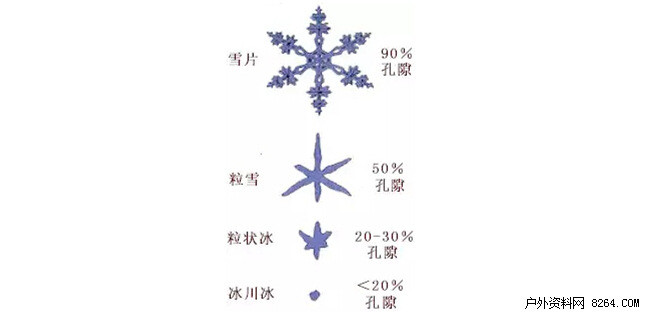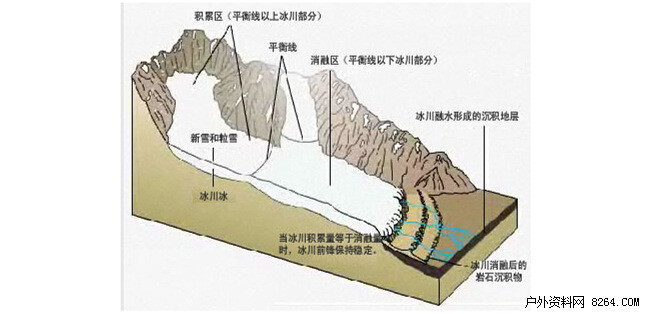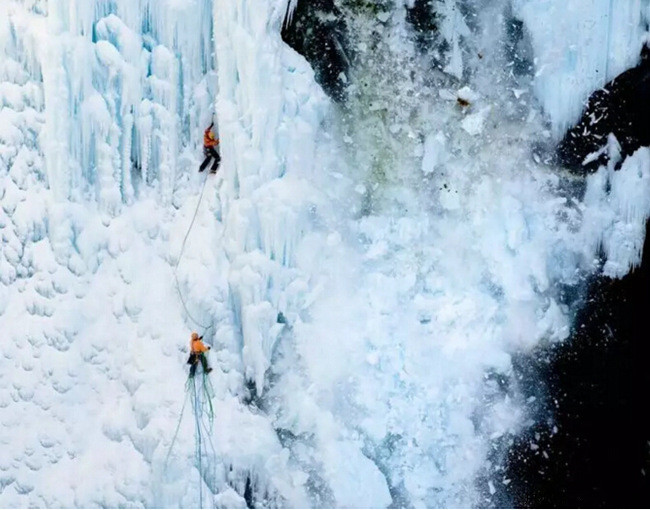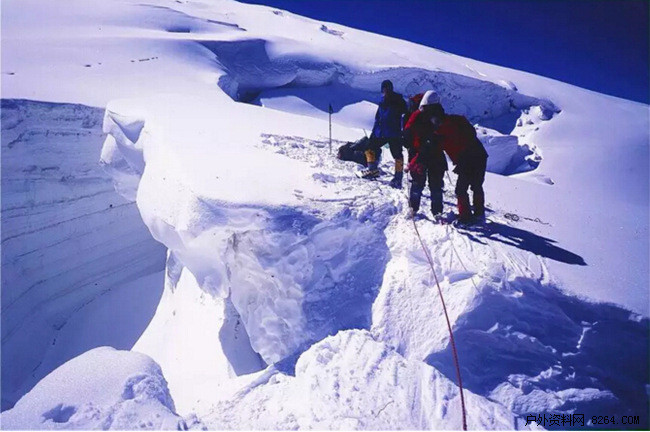
The glacier is a convenient route to the summit of the high mountains, but climbing the glacier requires extremely professional climbing skills because the walkers must pass through the glacier cracks. That is, when the glacier slowly moves toward the foot of the mountain with a large frozen snow, due to thermal expansion and contraction between day and night, a glacier crack will divide the glacier. Although climbing a glacier is dangerous, it is indispensable for mountaineering activities. To become a professional climber, you must have the ability to cross the cracks of the glacier.
Glacier formation
The glaciers formed this way: In the middle of the year, no melting snow will accumulate in the winter of the following year. Year after year, the snow will eventually freeze, and slowly begin to move down the mountain, and the glaciers are formed.
In the old snow, the crystals of snow have become ice particles. Now, ice pellets will become glacier ice through old snow. When the air gap between the ice particles is sealed, the snow blocks become dense, and the old snow becomes glacial ice.
Snowy water infiltrates into the lower snow layer every spring. The temperature of these snow layers is below zero, so the meltwater will freeze again, forming ice in the aged snow, so when the entire aging snow area has experienced density and metamorphism When you are ready to become glacial ice, it may already contain irregular ice.
After the formation of glacial ice, metamorphism did not stop. Ice pellets will continue to "swallow" their neighbors and continue to grow, so the volume of ice crystals will increase over time. It takes hundreds of years for the ice in a large glacier to reach the end of the glaciers, so the tiny crystals of snow may eventually be larger than 30 mm in diameter. (When the snow crystals become aged snow crystals, and then change from aging snow crystals to glacial ice crystals, the volume will continue to increase).

We can imagine the birth of a valley-like mountain glaciers. If there is a mountain in the northern hemisphere where there was no glaciers, the snow in the shade of the mountains will not be transformed all the year round due to changes in the climate. Initially, snow flows at a very slow speed to the valley. Because new snow is added every year, the snow will get deeper and deeper, the area will increase, and the amount of snow flowing will increase correspondingly. As the slow-moving snow moves the mud and rocks, the snow is continuously melting and freezing again, and the water around and below the snow blocks constantly impacts the surrounding environment. After a long period of accumulation, this small-scale erosion eventually produced surface voids, and winter snow accumulated above the potholes. When the snow depth is more than 30 meters, the lower snow turns into glacial ice under the increasing pressure of the old snow. The glacier was born.

As winter snow continues to squeeze, the glaciers will move down the valley in the form of ice streams. If the glaciers reach a warm place on the move, there will be no new snow in the glaciers, and the glaciers will begin to melt. Eventually, the glaciers will flow to a lower and warmer place where the glaciers will all melt - this is the end of the glaciers.
Some glaciers consist of slow-moving snow blocks, while others run from high places with heavy snow blocks. In a region where climate change is very regular, the movement of glaciers is achieved through internal changes and sliding on the river bed. Glaciers move at a rate similar to that of rivers: the central and surface flows fastest, and the bottoms on both sides of the river and the riverbed are the slowest. The appearance of a polar glacier is very different from that of a typical glacier—because it is frozen in the riverbed and can only flow through internal changes. Polar glaciers are like flowing sugar syrups, and glaciers are like rivers full of crushed ice.

Glacier and glacier cracks
The glaciers are constantly changing, and the amount of snowfall and temperature will affect the progress and retreat of the glaciers. On the picture, the glaciers look like a frozen river, slowly flowing down the hill. However, glaciers are very different from real rivers in many respects. Some glaciers are small and look like a stationary snow and ice. Some glaciers are vast ice fields, showing a shaky state and once they are dumped, they are overwhelming.
The flow pattern of glaciers is extremely complex, but the typical alpine glaciers have flow rates of between 45 and 400 meters per year. In the warm summer, most of the glaciers will flow faster than the winter, because of the impact of the ice and snow melting into water. When the glaciers flow, the surface of the ice can be broken into many natural hazards, that is, glacier cracks.
Glacier crack
Glacier cracks are an important feature of glaciers. If the ice is subjected to pressure beyond its tolerance, the ice will break and the resulting section will be a glacier crack. Ice blocks on the surface of the glacier are formed for a short period of time. There are many small gaps in the ice, and the adhesion between the crystalline ice is also weak. Once it is stretched or bent too much, it will break like a glass.
The depth of cracks in general glacier is 25-30 meters. Ice depths above this depth are more solid, ice crystals will grow bigger and stronger, and adhesion will become stronger. When subjected to the pressure of trying to separate it, its internal structure becomes more compact due to pressure, and its appearance is also like thick syrup. As for the cooler glaciers—glaciers at high altitudes or polar climates—the glacier cracks may be deeper. The lower the temperature is, the more brittle the ice is, and it is easier to break.
Compared to polar glaciers, glaciers in temperate regions have many cracks, because glaciers typically move faster. When the glaciers flow quickly, for example through a large gap, large-scale fractures will occur, resulting in icefalls. The separate icicles formed after several glacial crevices are connected to each other are called ice towers.
Glacier cracks tend to form at steep slopes in the mountains, where the snow often breaks due to crushing. Glacier cracks are also often formed where the glaciers turn or where two glaciers confluence. In particular, the more cracks are closer to the outer edges, because the valley walls at the turn do not narrow or widen. As rock beds impede the flow of glaciers, glacial cracks often stretch around rock beds, such as near a rock protruding from the ice. If the flowing glaciers separate from the snowcaps or icecaps that have not been removed for thousands of years, they will form large glacial crevices and become backlashes. In general, the glacier in the center of the glaciers has fewer cracks than the edges, and glacier cracks formed by glaciers with low gradients are generally less fragile than rapidly flowing steep glaciers.
Glacier cracks in the accumulation area are the most dangerous. Because the glaciers in these areas are very high, more snow is added each year than the amount of melted snow. In such places, glacier cracks are often covered by snow bridges, and these snow bridges are very fragile, and even one person’s Unable to support weight. At areas below the accumulation area, the annual amount of snowmelt on the glaciers may equal or exceed the amount of snowfall that year. Between these two areas is the snowline of the million years, also known as granular ice and snow.
Deeper glaciers are denser and more malleable than the upper layers, so the flow does not crack when deformed. If these deep, age-old ice and snow are exposed to the surface, the glaciers will present a layered, seamless, and seamless appearance that will not normally crack into cracks. It is relatively safe to climb on such glaciers. Simple, because they are often very flat, even if there are cracks are narrow and fine, very good.

Ice collapse
When the suspended glaciers, icefalls, and any part of the glaciers covered by ice towers pours down, the ice that falls will probably collapse from a steep, mixed icefall. This is the ice collapse. It is caused by the combination of glacial flow, temperature, and the formation of ice towers. Ice collapse may occur at any time, and there is no absolute relationship with the season, temperature, or snowfall. However, most of the ice collapses occur at night when the temperature rises above the freezing point or falls below the freezing point. If you must go through these areas, you should avoid this time or move quickly and carefully.
In the late summer and early fall, ice falls occur more frequently on low-altitude warm glaciers because the meltwater is large enough to flow under the glaciers and the flow rate of the glaciers increases. Because the glaciers at high altitudes and at lower temperatures freeze on the river bed, this seasonal change does not occur.
When the ice collapse occurred most frequently, the parties said differently. Field observers believe that the ice collapse is most common in the afternoon. The ice tower ice covered by snow may be so, if the sunshine during the day makes the snow loose and collapse into an ice tower, and then cause the ice tower to collapse, it will cause an ice collapse. However, scientists have found that the frequency of ice-collapse is highest in the early morning because the ice cubes at this time are low in temperature and most likely to be broken. In fact, an ice collapse can occur in any season, and it does not matter whether it is day or night. It only happens at different frequencies.
Basic Rules for the Advancement of Glaciers
When climbing a glacier, it's good to leave early, but climbers are always hesitant about this approach. They hope that they will be able to move forward before the sun goes down on the snow bridges and the avalanche-like slopes. However, leaving too early will make them sleep less. The climbers had to bring their headlights before dawn and adjust the crampons, groping around to wear seatbelts, and were too busy to think about the conditions they would face when climbing the glaciers. However, through training, they will know how to prepare before climbing a long glaciers.
Rope climbing
The first rule of safe travel on the glacier is simple: rope climbing. Whether you are familiar with glaciers or whether you believe you can identify and pass through all glacier cracks, you must follow this code. It is particularly important to climb a rope in a mountainous area above the 10,000-year-old snow line. There are many glacier cracks in this area covered by snow.
When you walk on a glacier that looks like soft snow, you may feel that it is not a rope, especially after you have safely passed similar routes many times. This is a dangerous practice. Your tether takes the same time as you fasten the seatbelt when you are in the car. When you fall into a glacier crevice, the rope will greatly increase your chances of survival.
In the area below the snow line, if the glacial cracks are stable and easy to see, some climbers will not knot the rope when crossing the glaciers. However, this kind of no-rope approach is not recommended for climbers who do not have a lot of experience climbing glaciers.
On smooth ice, such as late in the snow season, knot climbing is not safe because it is almost impossible to ensure that you do not fall on glacier cracks on hard ice, and the results of knot climbing often fall into the glacier. crack. Whenever you decide whether to use knot rope climbing, you must first consider the environment.
If it is to cross the glaciers that are easy to travel, the most suitable number of people in the group is a trio. The reason is that when one of them falls into the glacier crack, the other two are enough to brake. A team must have at least two sets of ropes. If one group of accidents occurs, another group can help. In some cases, the four-person climbing team only has one team. This may be because one of them does not understand the technology or only one person in the team has rescue experience of glacial cracks.
Use ropes
Ropes are the necessary equipment for the glaciers' marching. When they are selected, they must abide by the relevant rules and play their due role.
The first rule to deal with ropes without remaining ropes is to allow the ropes to stretch naturally, not straining, or letting the ropes droop. If the rope between the companions is fully stretched, it can prevent falling into deep glacial cracks. Because once the rope is sagging, when one player falls into the glacier crack, the other players cannot immediately stop him from falling. The fallen person will fall deeper and more likely to hit the ice wall or be stuck. For the teammate who is responsible for braking, the extra rope will increase the possibility that he will be pulled down the crack.
When you arrive at a rest stop or camp, you must still pay attention to your safety. Before you have thoroughly explored whether there are glacial crevices in this area, your ropes must be kept stretched at all times without sagging. If you have already decided to camp on the glacier, you have to use a signpost to indicate a safe range. No matter where you are resting or camping, all incoming and outgoing players must ensure protective measures.
When the rope is running at right angles to the glacier's cracks on the glacier, try to keep the angle between the rope and the crack in the glacier as far as possible. Join a rope team and glacier cracks to move in approximately parallel directions. When a team member drops a glacier crack, it is likely to swing like a pendulum for a long time. Although it is not always possible to maintain a right angle between ropes and glacial cracks, if you are constantly vigilant, it will help to choose the safest route.
Finding Glacier Cracks
The first step in safely crossing the glaciers is to find out the cracks in the glacier and then plan ways to safely bypass them. Finding routes on glaciers depends not only on planning but also on experience and sometimes on luck.
Before you go, you can study the photos of the glacier before you make plans, because the appearance and location of some of the glacier cracks can be described as permanent. You can also find the latest reports and use the experience of those who have been to the area.
Before you set off, take a closer look at the surroundings of the glacier and you may find a clear route that is not easy to find. It is best to record the observations as text or drawings to help you remember the location of major glacier cracks, landmarks, and routes.
The pictures and bird's-eye view on the mountain guide are certainly useful, but when you are on the ground, you may be surprised to find that the cracks that look like small seams are actually huge deep trenches, and the glacier cracks may be deep hidden. It can't be seen on the map at all. If possible, plan a few more routes.
Once in the glaciers, an endless game of searching for glacier cracks began. Invisible, does not mean it does not exist. After arranging the camp, several team members can be sent to explore and plan the route before the sun goes down. This can save a lot of time for the next day's journey.
If you think that a certain area is very suspicious and you want to detect ice cracks, snow detection technology will come in handy. If ice cracks are found after the probe, continue to probe to determine the exact location of the crack.
Hail can be a detection tool. Insert the tip of the handle smoothly into the place about 50 cm in front of your standing position. The hail and slope must be kept vertical. If you continue to feel resistance during the insertion process, you can be sure that the depth of the snow is at least equal to the length of the hail; if the resistance suddenly drops, there may be a hole below the surface. If you have to move in the direction of a pit, you must use hailstone to insert it several times to determine the size of the pothole. Leading players should dig holes and mark them with signposts.
Whether or not you can accurately detect glacial cracks depends on your skills and experience in understanding snow changes. If the probes make you inexperienced, after the hail plugs into the cracks, they may feel like they are stuck in a softer snow layer. The length of hail can also affect the accuracy of the detection results. You may wish to use a lighter, finer, longer ski pole to detect. It is easier to insert snow than a hail and it can be inserted deeper.
The key to detecting ice cracks
Observe if there is a depression in the snow surface. If there is snow that is covered by ice cracks due to gravity, this is the main feature of the hidden ice cracks. The sun-drenched snow will have some visible differences in luster and texture, which will be more obvious in the early morning and early evening.
Be especially careful after the snowstorm. The newly-fallen snow may fill up the subsiding snow surface, making it indistinguishable from the nearby snow surface.
Pay special attention to areas where ice cracks can easily form, such as where glaciers turn and slopes rise.
Always observe both sides of the route to see if there is a gap. If yes, it means that the ice cracks have already extended to the bottom of the route. Finding an ice crack in one area often has more ice cracks in this area.
Through ice cracks
Bypass the end of the glacier
There are many ways for climbers to bypass the ice cracks. Here, we introduce only general techniques, and you must be flexible when you are there. Finding paths on glaciers means not only to bypass those visible ice cracks, but also to guard against hidden, invisible ice cracks. Even if the route through the glacier is carefully chosen, it is often the case that the original road is turned back and the route is being looked for. This is indeed frustrating, but it is best not to complain about it in order to ensure safety.

Going directly through the crevasses of the glacier is the most unacceptable choice for all climbers. Since the width of the ice crack becomes narrower as it approaches the end, the safest and most reliable method is to bypass it at its end. It must be a big circle, but it is much safer than going straight through cracks. After the melting snow falls in the summer, glacier cracks will be easier to identify. Other seasons may be covered by falling snow. They must be carefully surveyed in the far corners of the corner and carefully observed to determine whether it is an extension of ice cracks or snow bridges.

Snow Bridge
If you can't bypass the end of the glacier, choose the snow bridge. Deep snow in winter will become hard under strong winds, and it may form a snow bridge over ice cracks, and it will not melt until summer. There is also a more solid snow bridge, which is actually a slender isthmus that connects two ice cracks.
When you encounter a snow bridge, look carefully from the side before you step on it. If you are still not sure whether it is reliable or not, you can let the leader of the team get on the ground first. The second team member is on the side to make sure the posture is tightened to prevent the bridge from falling into the crack when it suddenly breaks. After the first player passes, the other players can follow the leader's foot after another player tightens the rope to ensure it.
The sturdiness of snow bridges is mainly affected by temperature. During the winter season or early morning, the snow bridge may be enough to support a truck. After the snow melts in the afternoon, it may not even support its own weight. Every time through the snow bridge must increase the period of menstruation, it can not be safely passed in the afternoon.
Skipping ice cracks
Skipping over ice cracks is not a common practice, unless you have no choice but to make sure that you may be struggling.
Before jumping, probe first to find the true edge of the ice crack. Teammates should be protected before the probe. If you need to run, first step on the snow can stand more stable. Then wear cold clothes, hat gloves, check seat belts and loops, and make sure teammates are protected. Hold the hailstone with the slip-braking grip to prevent it from climbing over the edges of the ice cracks as you step on it. Then jumped.
Once a player arrives on the other side, it is not so dangerous for other players to jump again. The opposing team can ensure that.
Climb down the ice crack
If ice cracks are shallow, there is a safer way: climb straight down, cross the bottom, and climb the other side. This method is only applicable to physically strong, well-trained, well-equipped mountaineering teams, because in addition to a good guarantee of protection, it is also ready to deal with some unexpected situations, such as when the bottom of the ice crack suddenly falls, leaving teammates suspended In mid-air, they can start rescue immediately. Also to be reminded that the seemingly solid bottom of the ice cracks is not reliable.
Trapezoidal formation
If the team's march must be parallel to the ice cracks, you may wish to line up in a trapezoidal team: the players walk on the sides or back of the front players, just like a ladder. If the glaciers are firm, although the cracks are dense, the location is easy to see and there are fewer hidden cracks. This trapezoidal formation is the safest. It is more pragmatic to arrange in a trapezoidal formation when the team members cannot follow the leader’s footsteps and only walk through the crack in a single column. However, if there are hidden ice cracks on the glaciers, it is not suitable to advance with the trapezoidal team.
Electric lifting TV bracket,After the TV is hung on it, it can be controlled by the remote control.Let the TV automatic lifting in addition to bring visual enjoyment, the benefits are quite a lot. When you don't watch TV, you can completely hide it, reduce the occupation of space, and avoid dust falling into it. It's more convenient and practical for families who don't watch TV often.

Tv Lift System,Tv Mount,Tv Lift Cabinet Systems,Tv Lift System Motorized,Remote Control Motorized Tv Mount
Suzhou Uplift Intelligent Technology Co., Ltd , https://www.uplift-system.com